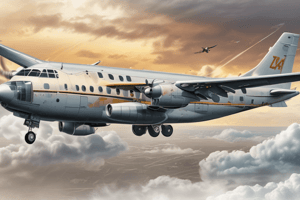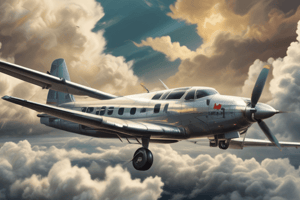Podcast
Questions and Answers
What is the distance & fuel to the alternate airport as per the company flight plan?
What is the distance & fuel to the alternate airport as per the company flight plan?
- 150 nm (41 min) / 7446 lbs fuel
- 324 nm (1H 37min) / 5899 lbs fuel
- 180 nm (53 min) / 7124 lbs fuel
- 224 nm (1H 5min) / 6686 lbs fuel (correct)
What is the definition of LLJ?
What is the definition of LLJ?
- Wind speed above 30 knots at 8000 ft
- Wind speed below 50 knots at 3000 ft
- Wind speed above 50 knots at any altitude
- Below 6000 ft, wind speed above 50 kt (correct)
What happens to saturated air as it descends?
What happens to saturated air as it descends?
- It will dry adiabatically (correct)
- It cools adiabatically
- It remains stable
- It becomes unsaturated instantly
How does ATC know the position of an aircraft?
How does ATC know the position of an aircraft?
What type of cloud is commonly found in a strong jet?
What type of cloud is commonly found in a strong jet?
What effect does a microburst downdraft have on aircraft performance?
What effect does a microburst downdraft have on aircraft performance?
Why is it beneficial for pilots to use a surface analysis chart for weather briefing?
Why is it beneficial for pilots to use a surface analysis chart for weather briefing?
What defines a low pressure system?
What defines a low pressure system?
How does TCAS work for aircraft collision?
How does TCAS work for aircraft collision?
Definition of pressure altitude?
Definition of pressure altitude?
Why would overcast clouds form over a house located on flat train south of a big lake?
Why would overcast clouds form over a house located on flat train south of a big lake?
Flashcards are hidden until you start studying
Study Notes
Flight Plan Overview
- Alternate airport is 224 nautical miles away, requiring approximately 1 hour and 5 minutes of flight time.
- Fuel remaining upon landing at the destination airport is 6,686 pounds.
Low-Level Jet (LLJ) and Pressure Dynamics
- Low-Level Jet (LLJ) defined as a wind phenomenon occurring below 6,000 feet with wind speeds exceeding 50 knots.
- Low-pressure systems are characterized by convergence, which is the coming together of air masses.
- When saturated air descends, it first undergoes dry adiabatic changes, affecting temperature and moisture content.
Air Traffic Control (ATC) and Weather Effects
- ATC determines an aircraft's position through its transponder, enhancing situational awareness and safety.
- In strong jet streams, cloud formations can include ragged cirrus clouds, indicating turbulent conditions.
- The Traffic Collision Avoidance System (TCAS) relies on Mode C transponders in other aircraft to work effectively, even if those aircraft lack TCAS equipment.
- Pressure altitude is determined by setting a standard mean sea level pressure, crucial for aircraft performance assessment.
Microbursts and Weather Impact
- The downdraft produced by a microburst can significantly reduce an aircraft's angle of attack (AOA) and lift, posing challenges during flight.
- In flat terrain areas, strong winds can lead to convergence and the formation of overcast cloud layers (OVC).
Weather Briefing Importance
- Weather briefings are enhanced through the use of surface analysis charts, which provide real-time weather conditions at specific times, aiding pilots in decision-making.
Studying That Suits You
Use AI to generate personalized quizzes and flashcards to suit your learning preferences.




